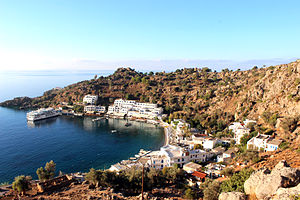Loutro (Sfakia)
Loutro ( Greek Λουτρό [luˈtrɔ] ( n. Sg. )) Is a village in the municipality of Sfakia on the southwest coast of the island of Crete . Loutro belongs to the local community of Anopolis .
Geographical location and traffic routes
Loutro lies between Chora Sfakion and Agia Roumeli at the foot of the White Mountains . To this day it has no road connection. The Anendyk ferries, which bring tourists from the Samaria Gorge to the bus station in Chora Sfakion, visit the village regularly in summer, and even several times a day in the high season. From July to September, taxi boats also run to the nearby beaches of Glyka Nera in the east (1 hour walk) and Marmara (1.5 hours walk) in the west. Loutro can also be reached on foot via the E 4 European long-distance hiking trail . You hike to Chora Sfakion in 2 hours and to Agia Roumeli in 6 hours. A kalderimi , restored at the beginning of the millennium, leads in serpentines to Anopolis and Kambia on the Anopolis plateau at an altitude of almost 700 m (ascent approx. 2, descent approx. 1.5 hours). However, this was partially blocked in 2007 by fences and a shepherd's runway and the connection to Kambia can no longer be found for non-residents. From Anopolis the further ascent to the Pachnes is possible.
history
Loutro is in the area of the ancient port city of Phoinix , where the apostle Paul wanted to spend the winter around AD 60 on his way to Rome after he set out from Kali Limenes ( Acts 27.12 EU ). Finix, the place in the neighboring bay to the west, is named after the ancient Phoinix . Cape Mouri, the headland between the two places, with its offshore islets, was also an important base for pirates and then for Venetian and Ottoman conquerors. The Venetian and Turkish fortifications have been partially preserved on Cape Mouri. There are also remains of settlements there.
During archaeological excavations stone tools from the old and middle Paleolithic came to light.
Economy and tourism
Since the 1960s the village has experienced an enormous tourist boom. Today the former fishing village is practically uninhabited from the end of October to mid-March, but all the more turbulent in summer. All houses in the village are used for tourism today. Most of the numerous taverns and hotels are in the hands of a few Sfaki families. There are also two supermarkets, a periptero and two small fashion and jewelry shops.
In spring and autumn it is mainly individual and hiking tourists who go on hikes from Loutro to Anopolis, the Aradena Gorge or the White Mountains. Since the 1990s, Loutro can also be booked as a flat rate, which British beach holidaymakers in particular take advantage of throughout the season.
Web links
Individual evidence
- ^ Peter Mortensen: Lower to Middle Palaeolithic artefacts from Loutró on the south coast of Crete . In: Antiquity . tape 82 , no. 317 . Cambridge University Press , September 2008, ISSN 0003-598X (English, antiquity.ac.uk [accessed April 17, 2018]).
Coordinates: 35 ° 12 ' N , 24 ° 5' E


